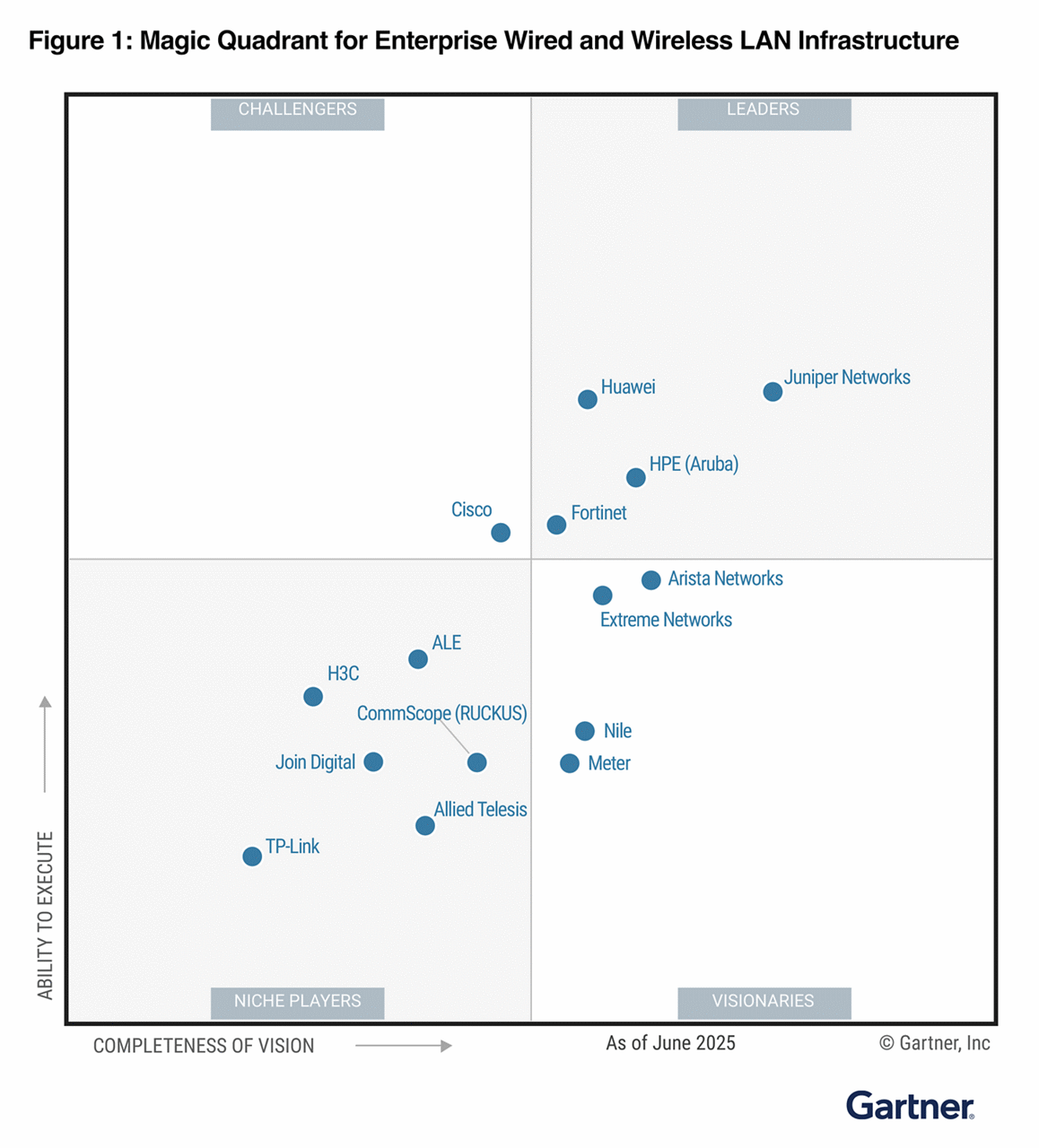
A Leader in the Gartner® Magic Quadrant™
Furthest in Vision, Highest in Execution
For the fourth time in a row, Juniper Networks is positioned furthest in “Completeness of Vision” and highest in “Ability to Execute.” See why Gartner recognized Juniper as a Leader in the 2025 Gartner® Magic Quadrant™ for Enterprise Wired & Wireless LAN Infrastructure.
3 key reasons everyone’s switching to Juniper Mist wireless
Greater resiliency
Unleash a truly modern cloud.
The Juniper Mist cloud-native platform scales elastically with your needs. With microservices, you get regular feature updates with no downtime.
____
Make network upgrades in minutes not months
Complete visibility
Move from reactive to proactive.
Don’t just see the network, optimize user experiences on it with the first and only AI-Native network. With Mist AI, you can proactively find and fix Wi-Fi issues before they become problems.
____
Eliminate up to 90% of help desk tickets
Increased efficiency
Get a stress-less, do-more network
Shrink your to-do list with self-driving operations, AI guided actions, and a 100% open API that works with every solution. Put your time, money, and resources into more strategic projects.
____
Save up to 85% in total OPEX
Why customers choose Juniper Mist vs. Cisco

Deployment flexibility and cloud management
Juniper’s wireless solution scales for all business sizes, boasting features such as single-click activation and comprehensive lifecycle management. Zero Touch Provisioning (ZTP) is implemented across devices with template-driven configurations, facilitating easy customization through site variables.
Cisco Meraki's infrastructure relies on virtual controllers that are hosted in co-located data centers. Switching between Catalyst and Meraki personas is a lengthy manual process.
Cisco's wireless solution operates mainly on-premises, lacking a cloud component for SDA. With a centralized controller, questions arise regarding monitoring options for Catalyst Access Points. Additionally, expensive Catalyst Center and Catalyst Spaces licensing is required for adoption.
Scalability
Unlock adaptability with elastic vertical and horizontal scaling capabilities. Juniper Mist APs reduce the need for additional costly hardware investments.
Cisco Meraki lacks elasticity and relies on virtual controllers (containers) hosted in co-located data centers.
Cisco Catalyst is non-elastic, necessitating additional controllers as APs are added or redundancy is required.
End-to-end visibility
Juniper Mist delivers end-to-end visibility and automated fixes across wired, wireless, and NAC domains.
Cisco Meraki provides insights through a cloud-managed dashboard but lacks comprehensive visibility across sequential events.
Administrators must navigate multiple, distinct products to diagnose and troubleshoot network challenges.
AI-driven RF optimization (RRM)
Harness the power of AI-driven RF optimization using reinforcement learning. Channel and power settings continuously optimize the user experience (SLEs) and reduce interference in real-time.
Basic RRM functionality, with the ability to monitor DFS failure patterns. While AP settings are retained post power failures, changes are restricted during 'busy hours', potentially compromising peak performance.
Cisco APs rely on a dated RRM system and lack AI and ML enhancements. The 15-year-old algorithm optimizes channel and power settings based on an AP intercommunication and interference graph. RRM adjustments occur on a static, periodic basis when the network load is at its lowest.
Cloud-native NAC
Built on a cloud-native Network Access Control (NAC) architecture, Mist APs lead modern network solutions. With embedded geographic redundancy and affinity, Juniper Mist APs provide robust, adaptable, and geographically harmonized networks.
Cisco Meraki APs are not built on a cloud-native NAC architecture.
NAC infrastructure design and deployment depends on client device demands, redundancy, and geo-affinity needs. Additionally, implementing feature or security updates requires planned downtime and manual execution on all servers in the cluster.
Virtual assistant
Experience the NOW of network management with Juniper's Marvis® Virtual Network Assistant. Using supervised machine learning, Marvis swiftly performs root cause analyses, seamlessly supporting wireless, wired, and WAN. Troubleshoot directly via WebUI or API without pulling logs.
Tethered to conventional network management methods, with a heavy reliance on dashboards and logs for insights and troubleshooting.
No virtual assistant for network management. Users navigate complex dashboards and sift through logs, leading to long resolution times.
Wireless that outperforms to make every connection count

The Business Value of AIOps-Driven Network Management

8 Reasons to Move to AIOps for Networking

Real World Benefits of AIOps

The Network for the Next Decade
See what Juniper can do for you
Find out why 5 of the Fortune 10 just switched to Juniper Mist™ Wireless. Talk to a sales specialist today or get a free Juniper AP and a 90-day free trial of our cloud services.
Gartner Magic Quadrant for Enterprise Wired and Wireless LAN Infrastructure, Mike Leibovitz, Christian Canales, Nauman Raja, Tim Zimmerman 25 June 2025.
Gartner does not endorse any vendor, product or service depicted in its research publications, and does not advise technology users to select only those vendors with the highest ratings or other designation. Gartner research publications consist of the opinions of Gartner’s research organization and should not be construed as statements of fact. Gartner disclaims all warranties, expressed or implied, with respect to this research, including any warranties of merchantability or fitness for a particular purpose.
GARTNER is a registered trademark and service mark of Gartner, Inc. and/or its affiliates in the U.S. and internationally, and MAGIC QUADRANT is a registered trademark of Gartner, Inc. and/or its affiliates and are used herein with permission. All rights reserved.
This graphic was published by Gartner, Inc. as part of a larger research document and should be evaluated in the context of the entire document. The Gartner document is available upon request from Juniper Networks.


































